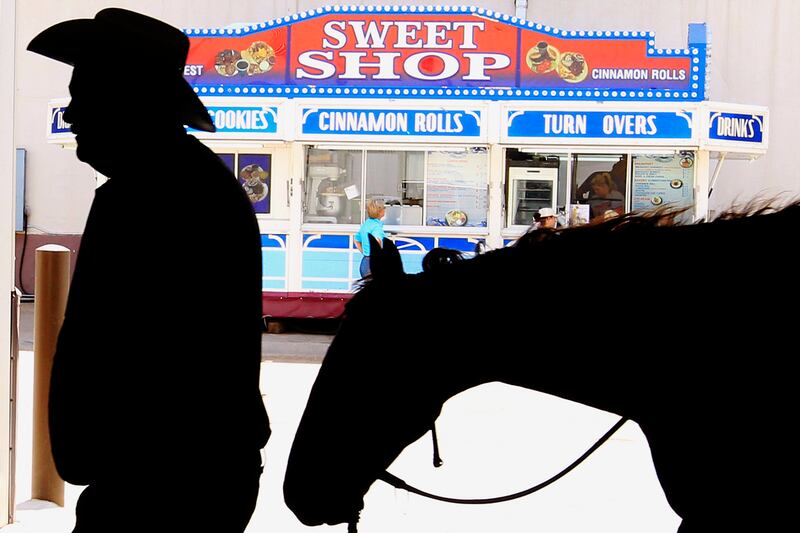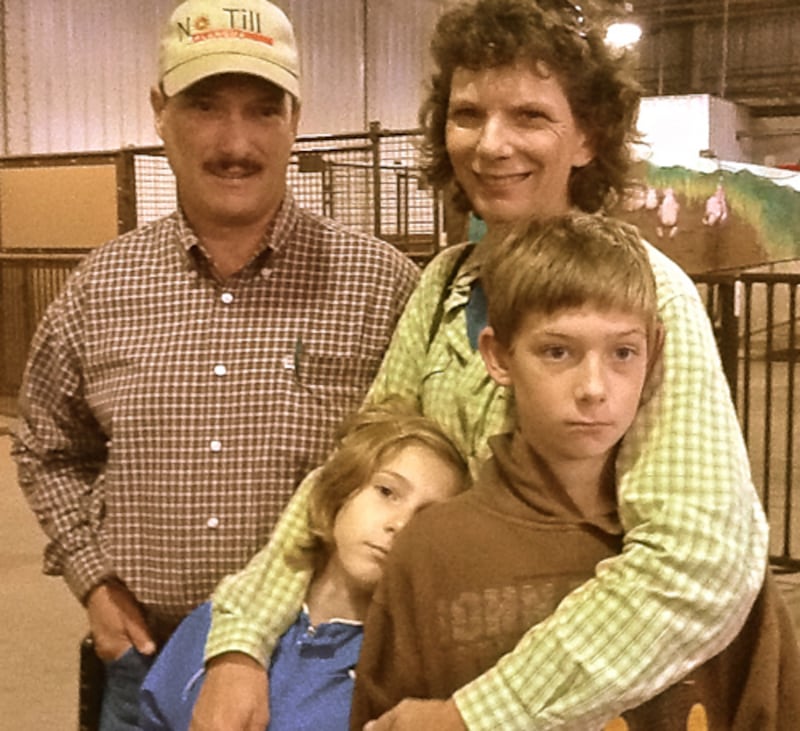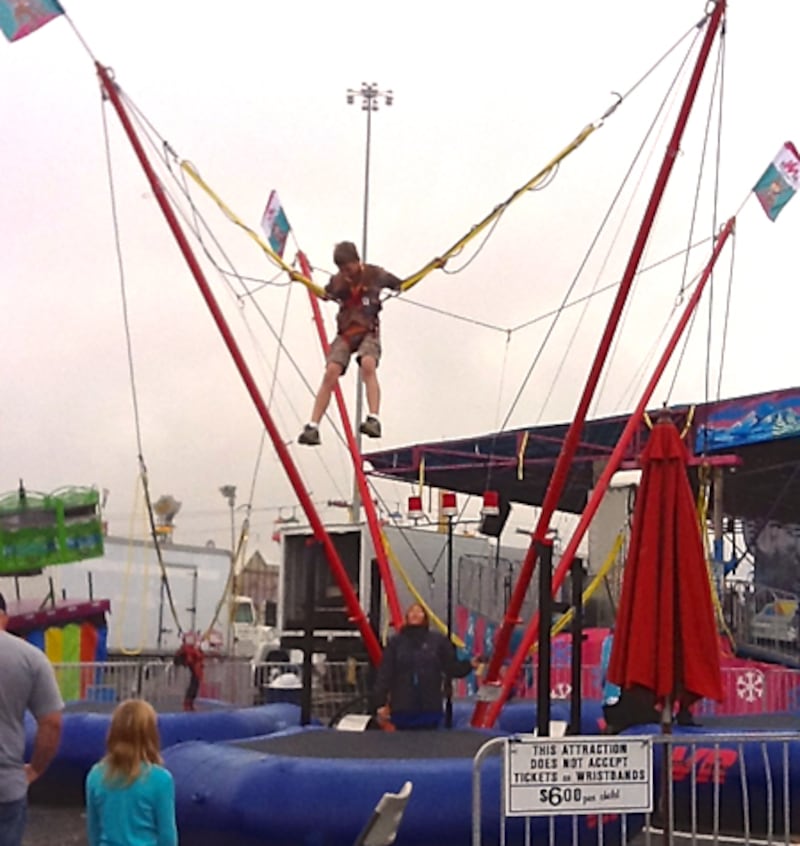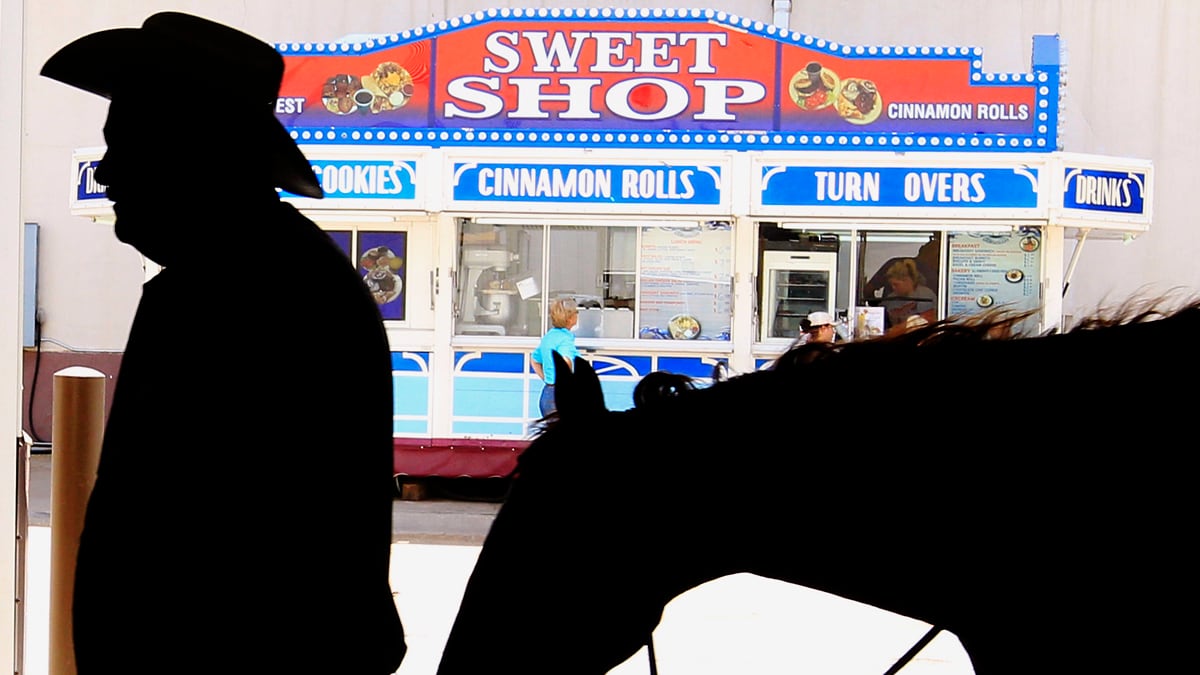Rain makes people in Oklahoma happy these days, even when it gets in the way of having fun. It was drizzling the day Karen and Rodney Jones attended the Oklahoma State Fair with their two children, Weston and Caroline. They just treated it like a joke.
“You told me I didn’t need my raincoat,” Karen teased her husband with mock severity.
“It’s not going to last,” he said.
“You just said that to make it rain,” she said with a smile.
These days Oklahoma will take rain under any circumstances. For two summers in a row most of the state has been mired in what the U.S. Drought Monitor characterizes as extreme to exceptional drought. North central Oklahoma, where the Joneses live and farm, got only 3.95 inches of rain all summer, the driest period for that area since 1921. The U.S. Weather Service predicts those conditions will prevail or intensify through the end of the year. Rodney estimates the two-year drought has cost them $350,000.
“This one, it just follows you around,” says Karen. “And it affects everyone; even the non-farmers are suffering and angry.”
Wet or dry, the Jones kids are looking for some fair fun. In no time, Caroline, 9, spies cowboy trick riders at the Centennial Frontier Experience, where horses are corralled, along with ponies, buffalo, and longhorn steers.
“Our little girl, like most little girls, just loves horses, much to her father’s chagrin,” says Karen. “So, shall we find some kind of animal barn, guys?”
Caroline and Weston, 11, both say, “Yes!”
Strolling through an exhibition hall’s long rows of stalls where horses are being groomed for exhibitions and competitions, Karen explains why a lot of the stall doors bear signs announcing the sponsorship of an energy corporation.

“That means a company pays the stall rental for these kids so they can afford to bring their animals to the fair,” she said. “I’ve only been here twice. I grew up in Oklahoma and when I was a kid, I had things exhibited at the state fair, I but never came. It’s a busy time of year at home. We’re usually planting wheat.”
Both Karen and Rodney come from families whose farming roots go back three or four generations—she grew up on the land they farm now—but otherwise they fit no conventional agricultural profile. Rodney, 50, has been farming since he was a high-school student in Kansas, but he also has taught farm management and agricultural economics at Kansas State and is currently the Oklahoma State University Northwest Oklahoma area agricultural economist. Karen worked for the U.S. Department of Agriculture for 17 years, until eight years ago, when the couple jumped at the opportunity to farm some of Karen’s family land. They’ve been expanding ever since.
Enid, where the Joneses live and farm on 3,000 acres, sits in the middle part of the state. “We’re what would be considered a medium-sized farm in our area,” Rodney says. “In eastern Oklahoma, that would be considered a huge farm. In western Oklahoma, it wouldn’t even be considered a hobby.”
“Until the last six years, there had never been anything but wheat planted on the land we farm,” Karen says. But the Joneses, like an increasing number of farmers, practice no-till farming, a technique in which the land isn’t turned and crop refuse is left from one year to the next to hold land in place. No-till does require crop rotation, so in “the last few years a lot of diversification has started to work its way into our part of Oklahoma,” Rodney says. “Wheat is still our primary crop, but we plant quite a bit of grain sorghum, some soybeans, a little bit of canola, and we’re trying some sesame on a smaller scale.”
The search for Clydesdales comes up empty, so the family strolls back outside, where the sky remains leaden but the drizzle has abated. Both kids are attracted to a live butterfly exhibit.
Watching her children watch the butterflies, Karen says, “I tried to grow a butterfly bush one year, but out here it’s just like standing over a plant with a blow dryer. It didn’t make it.”
High wind and heat are constants on the Oklahoma prairie. “We don’t have the climate to grow very good vegetables,” she says. “It’s hot and dry. You can grow a little bit here and there, and we all have gardens on our farms, but we could not live exclusively on that food.” And in the last two years, rainfall, which averages 34 inches annually, has fallen at about half that rate.
“We’ve been through different difficult times,” says Karen, “but last summer was just something we’d never been through, between the heat and the drought. The heat was probably the more significant factor. We all talk about the drought as though it was just a lack of rain, but it’s the intensity of the heat. It was so hot you couldn’t go outside and do anything. Normally we spend all our time outdoors, and you couldn’t.
“So we got through that, and then this year when it started in again, and we had 100 degrees and 100 degrees and it started feeling like déjà vu. We had to mentally get hold of ourselves and say, no, we’re not going there.

“One of the things I did was pick out one small plot in the yard and water it. Last year there was no green anywhere by the end of the summer, but this year I kept that one spot green. There was some psychological benefit to that. You could go out at 10 at night and it was still hot, but you could sit and it was like one thing you knew you could control.
“My parents were born in the midst of the Dust Bowl, so I heard those stories my whole life.”
“It’s probably not that different for farmers then and now,” Rodney says, “because last year and this year, with the heat and the lack of rain, it was pretty doggone discouraging.”
Caroline and Weston stay close to their parents as they navigate the midway, with Caroline often taking her brother’s hand as they move through the crowd. But when they pass a U.S. Marine recruiting booth, Weston steps forward to try his luck on the chin-up bar. He manages enough to win a lanyard from a buff Marine.
“What do you say?” Karen prompts. “What do you always say to soldiers?”
“Thank you,” he says, proudly gripping his prize.
When Karen offers them each a choice of one ride, Caroline demurs, but Weston makes a beeline for a contraption that’s part slingshot and part bungee jump. Strapped into a harness, he is soon shooting higher and higher into the air.
When it’s over, his mother says, “That was better than a ride, hunh?”
“That was a ride,” he exclaims. “That was the best thing that I have ever done in my entire life!”

Over lunch, Rodney carefully qualifies his discouragement over the drought: “Yes, it has made life difficult. It’s a challenge not unlike what other businesspeople face. We’re in a business that relies on producing something and selling it, and when environmental conditions make it incredibly hard to produce anything, that’s a big constraint.
“But you don’t want to go too far down that road, because people have found ways to get through it and survive and even hope to come out of it thriving. That’s the message we’d like to send.”
Today’s farmers, he argues, are much better positioned to endure the vagaries of the market or the weather than farmers were during the Dust Bowl. “We have a much different safety net in place,” he says, “especially for crop producers with the crop insurance program. We’re vested in that, we pay premiums against revenue loss; almost all producers do. That doesn’t mean you had a great year because you got an insurance payment that helped bail you out. It means you tighten your belt, you don’t buy new machinery, you cut your costs. But unlike in the ’30s, where you didn’t get anything, you have some revenue to help get you through. Another big difference is that we farm differently. We have much less erosion and more water retention.”
“The difference between then and now,” Karen says, “is that we can see beyond this. They couldn’t.” For today’s farmers, she says, “The drought is just a reality. It’s not a deal breaker.
“I spent years working for the U.S. Department of Agriculture, loaning money to farmers, and we were their last chance. We saw a lot of people go out of business.
“At one point we got a new secretary of agriculture, and he made us go through every file and find out what caused the failures. He thought we would find a single issue—oh, it’s a drought or this or that. But it was never any one thing. It was a series of events and a type of management that led them to that place. Yes, drought could be the final nail in the coffin, but it usually wasn’t just the drought. It was that they went out and got more debt to make up for the disaster and that was their demise.
“What we know is, we’ve got to find different ways of generating income besides, oh, the bank will loan us more money.”
In the Joneses’ case, that means that Rodney works two jobs, one on the farm and one off, and Karen works part time in an Oklahoma state program that counsels farmers on financial planning and management.
“It would be very difficult for us to maintain a reasonable family living standard and make it through these uncertain times if I didn’t have a full-time job off the farm,” Rodney says. “There are far fewer farmers now than there were 50 years ago who would be considered full-time farmers. There are some, but it’s also very common to have off-farm income, for a variety of reasons—the income, the insurance, the diversity.
“And frankly, the farm job that was a full-time job 20 years ago isn’t a full-time job today with modern technology. So you can’t expect something that’s not a full-time job to generate a full-time family living.”
Both Joneses are optimists, but extremely well-informed, bet-hedging optimists, which is to say that they never entirely stop thinking about the things they can’t control. And topping that list is weather, be it drought, heat, hail, or fire, which last summer wiped out more than 100,000 acres in Oklahoma, including part of the Jones farm.
“The day before we started wheat harvest,” Karen recalls, “I was going into town to get fuel. We have 80 acres between us and a housing addition, and right at the edge of the housing addition I saw that this fire was about 10 feet across and no fire trucks in sight. I picked up the phone and told my husband—the wind was what, 30, 35mph that day—I told him, ‘We just lost a quarter of our wheat.’
“We ended up losing 20 acres out of the middle, but it was the worst experience. It was coming right toward Mom’s house. The fire department was able to put it out. But it was almost the strong wind that saved it, because it burned almost a straight north path. It would’ve spread out if the wind hadn’t been so strong. But to stand and have that fire roaring toward me and be able to do nothing about it, it really made me understand how the prairie settlers felt with the lightning strikes.”
The family finished their day by attending a Science Museum Oklahoma show, the Agtropolis science and agriculture exhibition with live goats, a chick hatchery, and more butterflies, a Wild West comedy act, and the Zoppé Family Circus, a classy one-ring tent show set up on the fairgrounds.
The hapless circus clown whose act opened the show soon had Weston and Caroline in stitches. He bent over to pick up his hat. Just as his fingers touched the brim, his foot would kick the hat out of reach. He walked over to the hat, bent down, and the same thing happened. Again, and again and again, and every time he did it the laughter got louder. After watching the clown’s fifth or sixth failed attempt, Karen leaned over and said, “This is how we feel some years about getting a crop in.”





